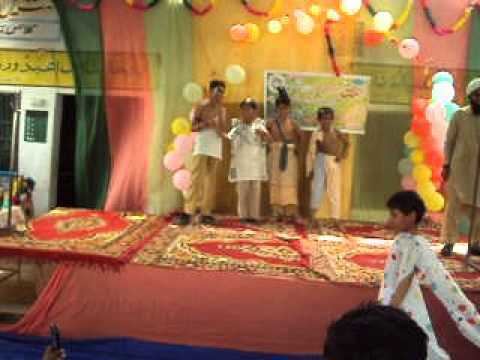Time zone PST (UTC+5) Elevation 116 m Area code 067 (Landlines) | Region Punjab Towns 1 PK 61230 (Post Office) Metropolitan area 10 km² | |
 | ||
Jallah jeem
Jallah Jeem (Urdu: جلّہ جِيم), or Jalla is a town near Mailsi, district Vehari, Punjab Pakistan on the bank of the Sutlej river. Jallah Jeem is famous for its mehndi (Urdu: مہندی) (Henna, Urdu: حِنا). Mehndi is the main industrial product and there are more than five grinding units of mehndi, one cotton ginning and pressing factory, one oil mill and two ice factories in Jallah Jeem.
Contents
- Jallah jeem
- Map of Jallah Jeem Pakistan
- People of jallah jeem
- Location
- Name origin
- Notable places
- Community and general information
- Deni madaris
- Masajid
- Languages
- Present situation
- Telecommunication
- Traditional fairs
- References
Map of Jallah Jeem, Pakistan
People of jallah jeem
Location
It is located 10 kilometres (6.2 mi) in the north-west of Mailsi, and is just 7 kilometres (4.3 mi) from famous Mailsi-Syphon Bridge on Sutlej river. The exact location is N+29° 43' 7", E+72° 8' 4". It is well connected by road to the other cities like Mailsi, Vehari, Multan, Bahawalpur and Lahore.
Name origin
Before the time of King Akbar, Jallah Jeem was called "Parganah Hakarah". The word "Parganah" was associated with that of tehsil today and "Hakarah" was because of the branch of Sutlej river track of which was this area, so this area was called "Parganah Hakarah". Mian Jallal-ud-Deen was a political and religious scholar appointed for political and religious advisory in palace of King Akbar. When King Akbar introduced Deen-e-Elahi for political gain and distorted Islamic ideology, Mian Jalal-ud-Deen resisted and finally withdrew himself from given status and rejected Deen-e-Elahi actively by participating the revolt along with Mujaddid Alf-Sani. Later, Mian Jalal-ud-Deen shifted to Lahore and participated politically for the revival of the true Islamic ideology. After death of King Akbar, King Jahangir felt the political unstable position and feelings of detachment of the Muslim community shook social and political roots, so he re-organized actively to promote Islam. For that King Jahangir contacted Mian Jalal-ud-deen and allotted him "Parganah Hakarah" to establish and promote of Islam. So Mian Jalal-ud-Deen migrated to "Parganah Hakarah" along with his family, including his brother Mian Azim-ud-Deen, and named this area as 'Jallah Jeem'. Here he built a fort to defend the Muslim community and to fight against the Hindus, because Hindu–Muslim conflict during Eid-ul-Azha on the cow slaughtering. Hindu–Muslim conflict can be assessed by the seven populous graveyards around Jallah Jeem and most of them are by name of martyrs, as Shehwan Shaheed, Gulchand Shaheed, Ibrahim Jatti Satti, etc. Names of mohallas, streets, sights, mandirs are signs of Hindus community as Giyan Thalla, Ghanaish Pura (Muhallah Usmania) etc. but nowadays the name of mohallas are vanjar pura, islam pura, etc. There was an old temple near Badshahi Mosque which was demolished in 1992 in response of Indian Babri masjid in Ayodhya, India.
Notable places
Community and general information
The people of Jallah Jeem are well educated, with a literacy rate of 85%. However, female literacy rate is lower, about 65%. There are eleven public and private schools with six madrassas. More than thirty doctors and engineers belong to the Jallah Jeem community. The basic caste system is still active and diverse, and national elections are also based on caste system (Bradari). Mainly people belongs to Arain, Mughals, migrated Muhajirs, Rajput's gotras (Saroya, Rao, Bhatti) Jhurer, Baghban and Aatishbaz families. Government Higher secondary school and Iqra Public School are prominent schools in the area are Razi model school. Alquid islamic school. al hadi school. faisal public school. A one standard school. radiant school and Beacon home school are in Jallah Jeem
Deni madaris
- Madrasa Khuddam Ul Quran (Established in 1953 by Molana Ghulam Ahmed sb who was very peaceful and great person of community)
- Jamia Al Farooq
- Madrasa Tajveed ul Quran. Hanfi Deobandi
- Madrasa Numan Bin Sabit
- Madrasa Fateh Ul Uloom
- markaz ahele hadith
Masajid
- Badshahi Jamia Masjid
- Jamia masjid Ali Ul Murtaza,Hanfi Deobandi
- Al Madina jamia Masjid,Hanfi Deobandi
- Makki Masjid,Hanfi Deobandi
- Masjid Usman e Ghani,Hanfi Deobandi
- Masjid Farooq e Azam,Hanfi Deobandi
- Masjid Bilal,Hanfi Deobandi
- Masjid Al Rahman,Hanfi Deobandi
- Masjid Ameer Muavia,Hanfi Deobandi
- Jamia Masjid Ameer Hamza,Hanfi Deobandi
- jamia musjid muhammadi ahele hadith
- Masjid e Aqsa, Hanfi Deobandi
- Masjid e Aysha,Hanfi Deobandi
- Masjid e ASNAY ASHRAYA (as)
Languages
Seraiki, Urdu, Haryanvi, Punjabi and English
Present situation
Jallah Jeem is main centre of Sunni–Shia conflict and considered the centre of Sippa e Sahaba abandoned movement. The situation is now controlled and no such incident of shia–sunni has been observed in the last five years. The town is very safe to live in, with basic needs of life, like phone, mobile phone service, hospitals, schools, a post office and gas.
Telecommunication
The PTCL provides the main network of landlines telephone service. All major mobile phone companies operating in Pakistan provide service in Jallah Jeem including 3G services. Broadband Internet access is available from PTCL.
Traditional fairs
- Shehvan Shaheed (Shadan Shaheed)
- Noori Khameesi
